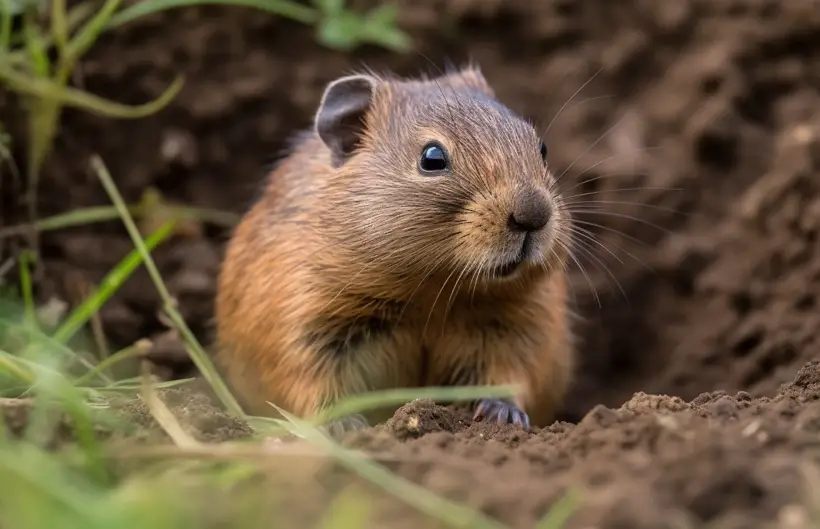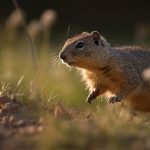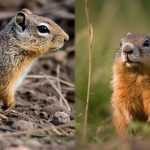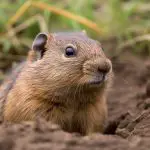What Does Gopher Poop Look Like?
Gophers are burrowing rodents belonging to the ground animal family, including squirrels, marmots, etc. The gophers normally live in the wild but often make their way through gardens and lawns. And destroy the soils and structure of the gardens through tunneling and poops.
Understanding the gopher characteristics and droppings is important to prevent lawn damage by gophers.
So, what does gopher poop look like? The shape, color, and size of the gopher poop typically depend on the gopher species and the diet of the rodent. Their diet is primarily dependent on plants, seeds, and so on. Gopher droppings are typically found in areas where they burrow or feed.
In this guide, we will discuss the details of identifying gopher poop. The understanding and identification will help you to prevent damage to lawns caused by these burrowing rodents. So, stay tuned till the end of the guide.
Identifying Gopher Droppings
Identifying the droppings is highly important to know about the presence of this rodent. This will help you to prevent the ground animal from causing plant and garden damage.

Let us dive deep into the details of how to identify gopher droppings!
Size, Shape, and Color
Gophers are a small type of rodent, and their droppings are also small. The size of the droppings usually measures about 0.25 to 0.5 inches in length. And the diameter of the gopher poop is about ⅛ inches.
If we compare the size of the rodent dropping to an element, it is roughly about the size of a small seed or a grain of rice.
The shape of the gopher poop is usually like a pellet, and the end of the dropping is slightly tapered. And the surface of the rodent dropping is typically shiny with a smooth and polished appearance.
As we mentioned earlier, rodents‘ diet typically depends on plants, seeds, and many more. And this diet plays an important role in the color of the droppings. Not only that, but the environment where the rodents live also affects the color of the rodent poop.
Usually, the color of the droppings is brown or black. However, the shade may vary slightly depending on the foraging habits and the vegetables the animal consumes in nature.
Differences Between Gopher And Other Rodent Droppings
In order to take proper measures to protect your plants and gardens, it is important to know the differences between gopher and other rodent droppings. Let us take a look at the differences between gopher poop from mice, rats, and so on.

The size of rat poop is quite similar to the size of gopher droppings. However, the shape, color, and pattern of the droppings are quite different. Rat droppings have a lighter color with a pointed shape and are usually scattered around. On the other hand, gopher poop is usually found in piles.
Mouse droppings are also quite common in yards, gardens, and lawns. They often take shelter in the gardens from predators. Even though the size is similar to gopher poop, the shape of the mouse dropping is flat with a dull color.
Differentiation of Gopher Poop from Dirt and Debris
Differentiating gopher droppings from other common garden debris, dirt, and so on is also important for wildlife removal. The difference between common debris and gopher droppings is that the shape of the poop is more uniform and smaller in size.
Leaves or grass clippings are typically looser, whereas the droppings are compact or dense. On top of that, the debris is usually spread throughout the garden. And the gopher poop is found in piles or clusters on the ground.
Gopher Droppings and Lawn Damage
Gophers are small species of rodents and belong to the family of rats, moles, and so on. These rodents are known for their burrowing habits, and this can cause severe damage to lawns and gardens.

Gophers are herbivores in nature and typically feed on the roots of plants and vegetables in the garden. And this feeding habit damages the crops and plants in the gardens. Not only that, but gopher droppings and lawn damage also result in soil composition trouble.
Plant And Lawn Damage
As we mentioned earlier, gopher droppings and garden damage are connected to each other. It often impacts plants and lawns significantly.
The feeding behavior of the rodents causes the plants to die, which in turn leaves patches in the garden. Not only that, but this feeding pattern also results in uprooting the small plants, which in turn ruins the landscape.
Impact On Lawn and Garden Health
Gopher droppings pose a serious threat to lawn and garden health. As the poop of the rodent decomposes, it breaks down. This results in a release of nitrogen into the soil of the garden. The nitrogen release causes unwanted plants and weeds to grow in the lawn, ruining the landscape.

These droppings can also be harmful to humans, animals, along with plants. This is because poop can often contain bacteria and germs. These germs will not only damage the lawn but will also cause infections and other harmful diseases.
Impact On Soil Composition
When it comes to soil composition, gopher poop can result in both positive and negative effects. As the droppings decompose, it releases organic matter into the soil. And this organic matter helps the plants to grow in a healthy manner.
However, this impact also varies depending on the soil types in the garden. On the other hand, the gopher droppings also release nitrogen which ruins the soil composition and impacts plant growth negatively.
Preventing Gopher Damage
Taking proper measures to prevent the damage caused by gophers is essential to keep your garden healthy. There are a few methods that you can rely on to ensure the prevention of rodents and wildlife from your garden. Check out these pest management methods here.

Plant Gopher Resistant Plants
One of the best ways of preventing gophers from attacking your lawn or garden is to rely on gopher-resistant plants. Trees or plants, including rosemary, lavender, and so on, are considered to be gopher resistant and can help to prevent backyard pests.
This is because the rodents are less attracted to these plants, which reduces the risk of burrowing and damage.
Ensure Proper Maintenance
Another great way of preventing garden pests is to ensure proper maintenance. Watering the plants regularly and keeping the lawn clear of dirt, leaves, and debris can help to keep the gophers away.
Not only that, but regular mowing of the lawn and healthy gardening practices will also keep the rodents away from digging the lawn. It will not only help with pest prevention but will also promote healthy plant growth.
Trapping Gopher
Lastly, you can try trapping the gopher to stop them from ruining your garden. You do not necessarily need to be harsh with them, so do look out for safer options to trap these animals.

Moreover, be considerate about the trapping regulations of the animal in your neighborhood. As they may be illegal, thus causing you some trouble if you are not careful.
If you’re curious about what gopher poop looks like, you might also be interested in our articles on how to catch a gopher with a milk jug and when gophers come out of hiding. Our article on how to catch a gopher with a milk jug provides a practical method for trapping gophers using a milk jug. Additionally, if you want to know more about the behavior of gophers and their activity patterns, our article on when gophers come out of hiding offers insights into their habits. By exploring these articles, you’ll gain valuable information on dealing with gophers, including trapping techniques and understanding their behavior.FAQs
Here are a few more additional questions you might be asking now.
Q: Are Gopher Droppings Dangerous To Humans Or Pets?
Typically, gopher droppings are not considered to be dangerous to humans or pets. However, oftentimes the droppings come with parasites, bacteria, and so on, which can result in several harmful diseases.
Q: Can Gopher Droppings Transmit Diseases?
Yes. Gopher droppings can transmit diseases such as viruses, infections, and so on. These diseases are typically transmitted through parasites mixed with droppings. Not only that but inhaling dust contaminated with gopher poop or urine can transmit several harmful diseases.
Q: Can I Compost Gopher Droppings?
Yes, you can compost gopher droppings to ensure better soil composition. However, it is important to make sure that the decomposing procedure reaches the required temperature to kill the harmful bacteria.
This will make sure that the gopher dropping does not impact the soil or plants in a negative manner.
Conclusion
Gophers play an important role in the ecosystem. But their droppings can impact the health and conditions of lawns and gardens. To keep your garden healthy and prevent infestation, identifying the gopher poop is a must.
Look for the shape, color, and size of the gopher droppings to identify their presence. Pest control companies also suggest proper care of your plants and lawn.
Do not forget to mow the lawn on a regular basis and plant gopher-resistant plants on the lawn. However, further research on the topic is extremely crucial to find effective ways of preventing gopher damage in lawns and gardens.




